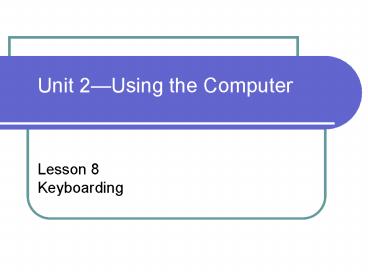Lesson 8 Keyboarding - PowerPoint PPT Presentation
1 / 28
Title:
Lesson 8 Keyboarding
Description:
Identify the parts of the standard keyboard. Identify the home row keys. ... toolbar, ruler, text area, vertical and horizontal scroll bars, and status bar. ... – PowerPoint PPT presentation
Number of Views:43
Avg rating:3.0/5.0
Title: Lesson 8 Keyboarding
1
Lesson 8Keyboarding
Unit 2Using the Computer
2
Objectives
- Define keyboarding.
- Identify the parts of the standard keyboard.
- Identify the home row keys.
- Identify the parts of the word-processing screen.
- Identify correct typing techniques.
3
Objectives (cont.)
- Type text without watching the keys.
- Save, print, retrieve, spell check, and format
documents. - Identify keyboarding software.
- Describe other types of input devices.
4
Keyboarding Techniques
- Learn to use the keyboard properly.
- Avoid hunt and peck method.
- Use time more productively.
- Identify different types of keyboards.
5
Keyboarding Techniques (cont.)
- Keyboard layout
- Alphanumeric keys
- Modifier keys
- Numeric keypad
- Function keys
- Directional keys
- Special purpose keys
6
Correct Position
- Position
- Sit up straight and lean forward slightly.
- Keep feet flat on the floor.
- Let elbows hang naturally at your side.
- Rest your fingers lightly on the
keyboard. - Keep your fingers slightly curved.
- Focus your eyes on the book or on
- whatever you are typing, not on the
keys.
7
Key Stroking
- Key stroking
- The home row keys are a, s, d, f, j, k, l, and .
- All keystrokes are made from the home row keys.
- Rest your fingers lightly on the keys.
- Keep fingers curved.
- Strike keys with a quick, snappy stroke and
return the finger to the appropriate home row key.
8
Position of Hands
9
Enter Key and Spacebar
Enter key
Spacebar
10
Workstation
- Your workstation
- Keep organized.
- Place materials you will type on the right.
- Place supplies on the left.
- Keep items you are not using off your desk.
11
Keyboard History
Ergonomic keyboard
- Early writing machines developed in 1800s
- Christopher L. Sholes
- invented first
- commercial typewriter
- in 1870 (QWERTY)
- Many modern variations
12
Early Typewriters
13
Developing Beginning Keyboarding Skills
- Much practice is required.
- Use good technique.
- Speed and accuracy are built around good
technique. - Concentrate on accuracy speed will come later.
- Learn alphabetic keys first, then numeric keys
and symbols.
14
The Computer Screen
- Document title (title bar)
- Menu bar
- Standard toolbar
- Ruler
- Text area
- Vertical scroll bar
- Horizontal scroll bar
- Status bar
15
The Computer Screen (cont.)
16
Printing and Closing
- To print
- Click File on the menu bar and then select the
Print command, or - Click the Print icon on the toolbar.
- To close
- Click File on the menu bar and then click the
Close command, or - Click the window Close button.
- If necessary, save your file.
17
Retrieve a File
- Click File on the menu bar and then click the
Open command. - Select the folder and file.
- Click the Open button in the Open dialog box.
18
Spell Checking, Grammar, and Thesaurus
- The spell checker checks the document and stops
on words it does not recognize. - The grammar checker flags possible grammatical
problems. - The thesaurus provides a list of synonyms.
19
Formatting Features
- Formatting features are used to enhance the
appearance of documents. - Word-processing software provides many special
characters that typewriters did not have such as
em dashes, smart quotes, and stacked fractions.
20
Formatting Features (cont.)
- Characters on a typewriter are monospaced, while
most computer typefaces are proportional. - When using proportional typefaces, two spaces
after sentences are not necessary.
21
Other Features
- Keyboarding software
- There are several software programs available for
learning to keyboard. - Speech recognition
- Software that allows the user to talk to the
computer rather than typing information
22
Developing Keyboarding Skill
- Requires
- Practice
- Practice
- Practice
- And more practice! ! !
23
Summary
- Keyboarding (or typing) is the process of
inputting text into a device, such as a computer,
by pressing keys on a keyboard. - The standard keyboard contains alphanumeric keys,
modifier keys, numeric keypad, function keys,
cursor movement keys, and special-purpose keys
(Esc, Print Screen, Scroll Lock, and
Pause/Break).
24
Summary (cont.)
- The home row consists of the following keys A S
D F J K L and . - Bump keys are located on selected keys on some
keyboards to assist in the correct placement of
your fingers.
25
Summary (cont.)
- The primary parts of an opening word-processor
screen are the title bar, menu bar, Standard
toolbar, Formatting toolbar, ruler, text area,
vertical and horizontal scroll bars, and status
bar. - Using correct techniques is very important in
developing keyboarding skill. These techniques
cover posture, key stroking, and the organization
of your workstation.
26
Summary (cont.)
- You should save your work often.
- You can retrieve files that have been saved.
- The spell checker checks a document for words it
does not recognize. It gives you several options
when incorrectly spelled words are found.
27
Summary (cont.)
- You may enhance the appearance of your document
by using the formatting features available in
most software programs. - Keyboarding software is available for learning to
keyboard. - Speech recognition software allows you to talk
to your computer to enter data.
28
Summary (cont.)
- Digital pens, PDAs, handwriting recognition,
mobile tablet PCs, and touch screens are other
tools that can be used to input data.

